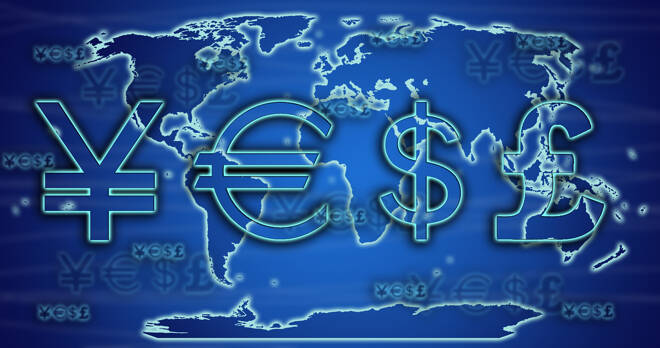Advertisement
Advertisement
Retail Sales Put the Loonie and the Pound in Focus, as Geopolitical Risk Lingers
By:
Retail sales figures will give the Pound and the Loonie direction, with the ECB minutes also in focus. Trump's Twitter account could be the key driver, however.
Earlier in the Day:
It was a relatively quiet day on the economic calendar this morning. The Kiwi Dollar and Japanese Yen were in action, with retail sales and inflation figures in focus.
Away from the economic calendar, the U.S government’s plans to ban Chinese companies from U.S Exchanges continued to be a test.
On the coronavirus front, a pickup in the number of new cases in the U.S may start to garner attention if the trend continues…
Looking at the latest coronavirus numbers,
On Thursday, the number of new coronavirus cases rose by 106,139 to 5,188,800. On Wednesday, the number of new cases had risen by 99,724. The daily increase was higher than both Wednesday’s rise and 93,671 new cases from the previous Thursday.
France, Germany, Italy, and Spain reported 1,976 new cases on Thursday, which was down from 2,856 new cases on Wednesday. On the previous Thursday, 4,230 new cases had been reported.
From the U.S, the total number of cases rose by 28,089 to 1,620,080 on Thursday. On Wednesday, the total number of cases had risen by 21,408. On Thursday, 14th May, a total of 26,397 new cases had been reported.
For the Kiwi Dollar
Retail sales fell by 0.7% in the 1st quarter, quarter-on-quarter, following a 0.70% increase in the 4th quarter. Core retail sales rose by 0.6%, quarter-on-quarter, following on from a 0.5% increase from the 4th quarter.
According to NZ Stats,
- 8 of 15 industries had lower volume sales in the March quarter.
- Motor vehicle and parts retailing tumbled by 7.5% to lead the way, with food and beverage services sales sliding by 6.7%.
- Accommodation services saw a 9.3% slide, with clothing, footwear, and accessories down by 6.6%.
- On the rise were supermarket and grocery store sales, which jumped by 8.5% to lead the way.
The Kiwi Dollar moved from $0.61236 to $0.61261 upon release of the figures. At the time of writing, the Kiwi Dollar up by 0.10% to $0.6120.
For the Japanese Yen
In April, inflationary pressures vanished, with Japan seeing an annual rate of core deflation of 0.2%. In March, the annual rate of inflation had stood at 0.6%, according to figures released by the Ministry of Internal Affairs and Communication. Economists had forecast an annual rate of core deflation of 0.1%.
Month-on-month, consumer prices fell by 0.2% in April after having stalled in March. The annual rate of inflation softened from 0.4% to 0.1%.
The Japanese Yen moved from ¥107.628 to ¥107.618 upon release of the figures. At the time of writing, the Japanese Yen was down by 0.06% to ¥107.68 against the U.S Dollar
Elsewhere
At the time of writing, the Aussie Dollar was up by 0.05% to $0.6568.
The Day Ahead:
For the EUR
It’s a particularly quiet day ahead on the economic calendar. There are no material stats to provide the EUR with direction.
On the monetary policy front, the ECB monetary policy meeting minutes are due out later today and will draw some interest.
The markets will be looking for what the ECB has left to offer by way of support and whether there’s any tension in the camp…
Away from the economic calendar, expect the news wires to also influence. Renewed tensions between the U.S and China remains negative for the EUR, while the ongoing easing of lockdown measures are positive.
The number of new COVID-19 cases continues to sit at sub-1,000 levels across France, Germany, Italy, and Spain and it will need to stay that way.
The positive COVID-19 numbers together with the expectation of further fiscal support should limit any downside.
At the time of writing, the EUR was up by 0.02% to $1.0952.
For the Pound
It’s another relatively busy day ahead on the economic calendar. Key stats include April’s retail sales figures.
The markets are not expecting the numbers to provide the Pound with any support, with the UK in deep lockdown throughout April.
Brexit and COVID-19 news will remain the key drivers. The current week uptick will need to be accompanied by an easing in lockdown measures to support a breakout.
There have been plenty of concerns over the Government’s handling of the COVID-19 pandemic. This has limited the government’s ability to ease lockdown measures.
A combination of negative Brexit updates and extended lockdown measures will likely continue to pin back the Pound.
At the time of writing, the Pound was up by 0.07% to $1.2232.
Across the Pond
It’s a quiet day ahead on the U.S economic calendar, with no material stats due out to provide the Dollar with direction.
A lack of stats will leave the Dollar firmly in the hands of chatter from Beijing and the Oval Office…
The Dollar Spot Index was up by 0.04% to 99.405 at the time of writing.
For the Loonie
It’s a relatively busy day on the economic calendar. Key stats include March retail sales figures.
Another slide in sales would pressure the Loonie, though any moves will likely be short-lived.
The continued global easing of lockdown measures and the rise in demand for crude remain positives for the Loonie.
On the downside, however, is the risk of another full-blown U.S – China trade war that could muddy waters.
At the time of writing, the Loonie was up by 0.06% to C$1.3946 against the U.S Dollar.
About the Author
Bob Masonauthor
With over 28 years of experience in the financial industry, Bob has worked with various global rating agencies and multinational banks. Currently he is covering currencies, commodities, alternative asset classes and global equities, focusing mostly on European and Asian markets.
Advertisement
